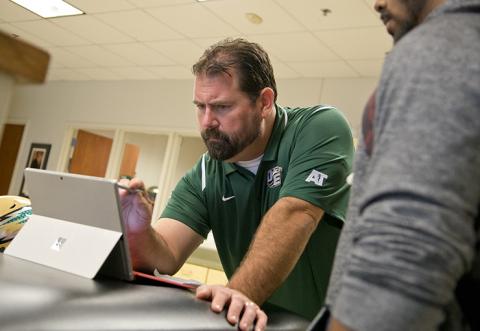
By Lisa Walker, ATC
NATA SSATC District Seven Representative
Working in the secondary school setting is rewarding and presents some challenging issues in knowing the rules of sport that apply to all participants, including the AT. How much do you need to know about each sport?
There are basic rules of sportsmanship that apply to all participants, including coaches and ATs. Have you ever heard of the AT being “ejected” from the game or given a technical foul for things that she might say or for behavior that is not allowed by a “non-player”? It happens regularly at all levels. Anytime an AT is present, you are considered to be a non-player part of the team and can be penalized as such.
When can you enter a field or sideline? This changes based on the sport. Does it require you to gain permission from an official? In most cases, it does. How many non-players can enter the field once permission is granted and what type of non-player can enter? If entry to the field is for a conference, where can the conference take place? In most cases, once an AT enters the field to tend to an injured player, the player must leave the contest for at least one play or the player is ruled an illegal participant.
There are rules related to health care and safety. What is allowed in regards to tape, padding or bracing? Again, this will vary by sport. Have you ever had a basketball official tell you that only “commercial” straps are allowed on the knee and a knee strap made of pre wrap does not qualify? This may be an issue by state, so know your state rules as well as national guidelines.
What are the rules regarding bleeding or blood on a uniform? When blood is identified does the player need to be removed from play or is there a set amount of time allowed to correct the bleeding and return the player to the contest? Is communicable disease addressed and is it a problem when it comes to a player being eligible to compete? Whose responsibility is it to disqualify the player? In wrestling, there is a mandatory form that must be filled out and signed by the appropriate health care professional for suspicious lesions. Even with the required document, on site medical personnel or other named individuals may legally overrule the original note. Most ATs are aware that wrestlers work off of injury and blood clocks. Do you know how much time is allowed for an injury? Do you know how much time is allowed to stop the bleeding and how much time is allowed to clean up the bleeding? Then there is the matter of recovery time in the event the official ruled an opponent violated rules, which created the injury.
Are concussions treated differently than other suspected injuries, and if so, how? State laws vary when it comes to youth and concussions, as do the rules in treating them.
There are many rules that ATs need to know. Making yourself familiar with the rules is a long process and many lack the time to look it up or the knowledge on where to begin to look. Consult the books: each sport’s rulebook, which are often available online, as well as National Federation of State High School Association (NFHS) rulebooks. Online access generally requires a fee.
State associations can alter the rules for their state, though it is rare. In some cases, the rulebook may lack the term “athletic trainer” or “attendant.” NFHS also has a Sports Medicine Handbook to which every AT in the secondary school should have access.
Rules are updated annually. In the event of a rule change, of any kind, notification is sent by the NATA Secondary School Athletic Trainers’ Committee (SSATC). These rule changes are sent to all ATs who list secondary school as a work setting in their NATA member profile.
First you must become familiar with the rules of sport, by sport, that apply to your work setting. After you have done that, watch your inbox for updates.
If you have questions, please contact your NATA SSATC representative.





